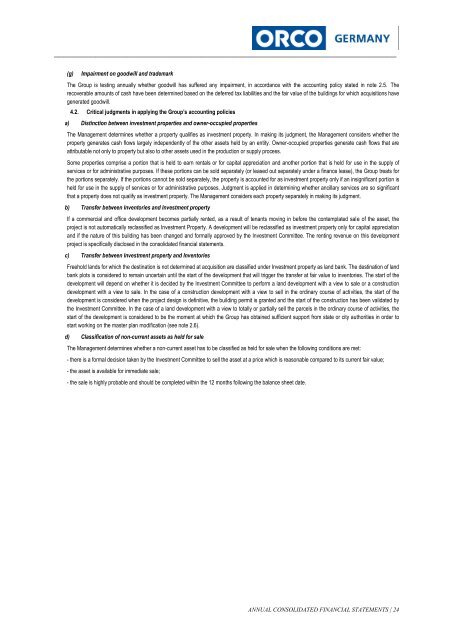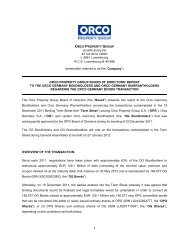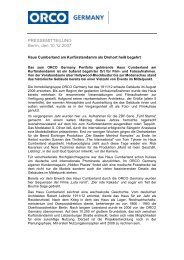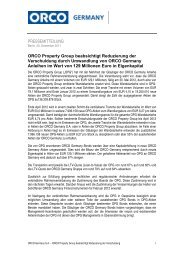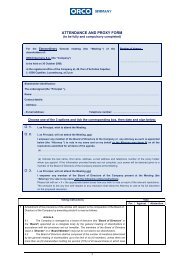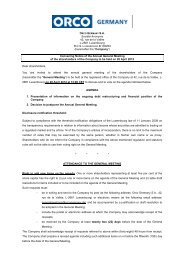Annual Report 2012 - ORCO Germany
Annual Report 2012 - ORCO Germany
Annual Report 2012 - ORCO Germany
Create successful ePaper yourself
Turn your PDF publications into a flip-book with our unique Google optimized e-Paper software.
___________________________________________________________________________<br />
(g)<br />
Impairment on goodwill and trademark<br />
The Group is testing annually whether goodwill has suffered any impairment, in accordance with the accounting policy stated in note 2.5. The<br />
recoverable amounts of cash have been determined based on the deferred tax liabilities and the fair value of the buildings for which acquisitions have<br />
generated goodwill.<br />
4.2. Critical judgments in applying the Group’s accounting policies<br />
a) Distinction between investment properties and owner-occupied properties<br />
The Management determines whether a property qualifies as investment property. In making its judgment, the Management considers whether the<br />
property generates cash flows largely independently of the other assets held by an entity. Owner-occupied properties generate cash flows that are<br />
attributable not only to property but also to other assets used in the production or supply process.<br />
Some properties comprise a portion that is held to earn rentals or for capital appreciation and another portion that is held for use in the supply of<br />
services or for administrative purposes. If these portions can be sold separately (or leased out separately under a finance lease), the Group treats for<br />
the portions separately. If the portions cannot be sold separately, the property is accounted for as investment property only if an insignificant portion is<br />
held for use in the supply of services or for administrative purposes. Judgment is applied in determining whether ancillary services are so significant<br />
that a property does not qualify as investment property. The Management considers each property separately in making its judgment.<br />
b) Transfer between Inventories and Investment property<br />
If a commercial and office development becomes partially rented, as a result of tenants moving in before the contemplated sale of the asset, the<br />
project is not automatically reclassified as Investment Property. A development will be reclassified as investment property only for capital appreciation<br />
and if the nature of this building has been changed and formally approved by the Investment Committee. The renting revenue on this development<br />
project is specifically disclosed in the consolidated financial statements.<br />
c) Transfer between Investment property and Inventories<br />
Freehold lands for which the destination is not determined at acquisition are classified under Investment property as land bank. The destination of land<br />
bank plots is considered to remain uncertain until the start of the development that will trigger the transfer at fair value to inventories. The start of the<br />
development will depend on whether it is decided by the Investment Committee to perform a land development with a view to sale or a construction<br />
development with a view to sale. In the case of a construction development with a view to sell in the ordinary course of activities, the start of the<br />
development is considered when the project design is definitive, the building permit is granted and the start of the construction has been validated by<br />
the Investment Committee. In the case of a land development with a view to totally or partially sell the parcels in the ordinary course of activities, the<br />
start of the development is considered to be the moment at which the Group has obtained sufficient support from state or city authorities in order to<br />
start working on the master plan modification (see note 2.6).<br />
d) Classification of non-current assets as held for sale<br />
The Management determines whether a non-current asset has to be classified as held for sale when the following conditions are met:<br />
- there is a formal decision taken by the Investment Committee to sell the asset at a price which is reasonable compared to its current fair value;<br />
- the asset is available for immediate sale;<br />
- the sale is highly probable and should be completed within the 12 months following the balance sheet date.<br />
ANNUAL CONSOLIDATED FINANCIAL STATEMENTS | 24


